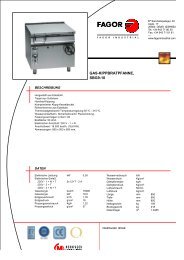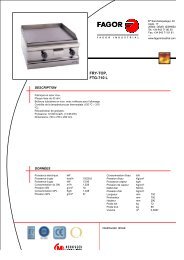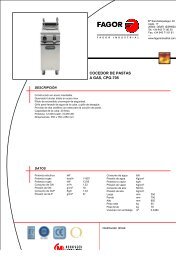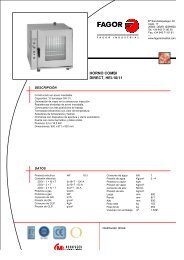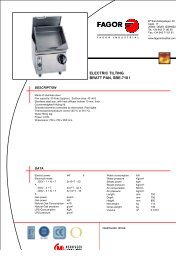Download - Fagor Industrial
Download - Fagor Industrial
Download - Fagor Industrial
Create successful ePaper yourself
Turn your PDF publications into a flip-book with our unique Google optimized e-Paper software.
FAGORNEWS 2013 TOGETHER WE EVOLVE FAGORNEWS 2013<br />
TOGETHER WE EVOLVE<br />
THE<br />
TECHNICAL<br />
CORNER<br />
CHOOSING<br />
THE RIGHT<br />
DISHWASHER<br />
When offering a dishwasher for sale or<br />
as part of a fitting-out project, certain<br />
factors should be considered to ensure<br />
that the selected model is the most suitable<br />
and that it meets the necessary<br />
production requirements.<br />
Assuming that the measurements for the<br />
washing area are correct and sufficient for<br />
installing the necessary appliances, the following<br />
factors should be considered:<br />
1 – Type and category of restaurant or<br />
premises. This will give the average size<br />
of tableware for each cover and the maximum<br />
dimensions of the plates or trays to be<br />
used, which will influence which machine to<br />
choose.<br />
2 – Average number of covers at peak times<br />
and time available for washing up.<br />
3 – True and theoretical performance of the<br />
dishwashers. The personnel available for supervising<br />
the dishwasher will influence the<br />
true production time of the machine.<br />
1. Type and category of restaurant or<br />
premises<br />
If you know the type of business or customer<br />
for whom the machine is intended, and the<br />
category of the restaurant, it is possible to<br />
obtain some of the more significant data<br />
used in defining the type of machine to be<br />
offered.<br />
On the one hand, you can obtain the average<br />
size of tableware to be used at each service,<br />
and on the other hand you can define the required<br />
machine dimensions in order to take<br />
the larger pieces of the tableware.<br />
1.1 Calculating the average theoretical<br />
production of a dishwasher<br />
A preliminary step when selecting the right<br />
dishwasher for an installation is knowing how<br />
to calculate the theoretical production of a<br />
dishwasher, given the different types of articles<br />
in the tableware required for one diner<br />
(plates, cutlery, glasses…).<br />
The average production of a dishwasher is<br />
based on a standard plate with a diameter<br />
of 230 mm. Dishwasher production tables<br />
are based on calculations using this type of<br />
standard plate.<br />
To calculate the required machine, each<br />
article of tableware must be numerically<br />
converted to a number of standard plates<br />
measuring 230 mm. in diameter The different<br />
capacities of baskets measuring 500 x 500<br />
mm to take the various pieces of tableware<br />
should be considered.<br />
1.1.1 Dishwasher baskets<br />
All tableware washed in industrial dishwashers<br />
is placed in standard 500 x 500 mm<br />
baskets, with different storages types and<br />
shapes depending on the articles for which it<br />
has been designed.<br />
There are baskets especially for plates,<br />
glasses, cutlery and trays, and multipurpose<br />
baskets which will take any article, but without<br />
the specific details required or needed<br />
for a good wash.<br />
Plate baskets have rows of tines which the<br />
plates rest against, at a suitable angle in order<br />
to receive the wash and rinse water.<br />
<strong>Fagor</strong> <strong>Industrial</strong>’s plate baskets, called CP-<br />
16/18, are so-called because depending on<br />
the position in which the plates are stacked,<br />
the distance between the tines varies according<br />
to the direction, so that either eight<br />
or nine rows of plates fit.<br />
The angle at which the plate is inserted in the<br />
machine depends on the depth of the plate,<br />
and is important for ensuring that the wash<br />
water hits the surface at the right angle. Flat<br />
plates need less of a slope for the water to<br />
wash across the surface, and therefore they<br />
can be inserted in rows of nine, thus increasing<br />
the capacity.<br />
Tumbler and wineglass baskets have closed<br />
compartments to prevent the glasses touching<br />
each other and breaking. To adapt to the<br />
diameters of the glasses, <strong>Fagor</strong> <strong>Industrial</strong> offers<br />
baskets with 16, 25 and 36 compart-<br />
Jose Ignacio<br />
Hurtado Alzaga<br />
Project Manager<br />
<strong>Fagor</strong> <strong>Industrial</strong><br />
ments (for diameters of 110 mm, 85 mm and<br />
70 mm), each of which comes in three different<br />
heights to adapt to the article in question.<br />
Thus there are nine options for glassware.<br />
34 #11 / JUNE 2013<br />
#11 / JUNE 2013<br />
35






